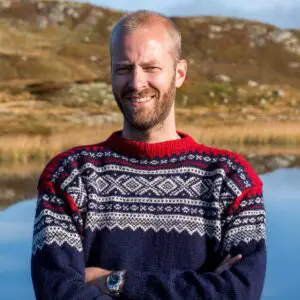Ut på tur, aldri sur. Out on a hike, never grumpy. This is a well known Norwegian saying, and spending time in nature is a big part of the Norwegian identity. Many people here in Norway, included me, spend a lot of time in the outdoors, hiking and camping in the wilderness. Norway is a great place for this because we have something called allemannsretten, the right to roam. This is a law from 1957 which regulates the publics access to nature. The good thing about this law is that it favors the people and not the landowners. So you are free to enjoy the great outdoors and breathe in as much of the fresh air as you want – if you follow certain rules and show respect for nature.
To fully understand the public right to roam the countryside. There are two important Norwegian words that you should know.
Innmark – Cultivated land
Innmark refers to cultivated land, such as farm yards, fields, residential sites, gardens, industrial estates and areas where public access would be of inconvenience to the landowner.

您可能还莱克阀门e:Foraging in Norway, Berries & Mushroom
Utmark – Uncultivated land

Utmark is uncultivated land. And includes most forest, mountains, beaches, and marshland.The right to roam applies to Utmark, meaning you can:
Roam around freely on foot or skis
Picnic and camp
Ride a horse or a bicycle on track and roads
Go swimming, kayaking, rowing and sailing
Forage flowers, mushrooms and berries
And you can fish in the sea
Now, with all this freedom, there are still some restrictions to be found. And here’s a few of them:
Some common questions about hiking and camping:
Where can I hike?You can hike On all uncultivated land in the countryside, whatever the season, on footpaths, tracks and roads. But you need to keep your distance from farmyards, private houses, and cabins, and not step onto any cultivated fields.
With a dog?A dog needs to be on a lead at all times from 1st of April until 20th of August
Can I light a fire?If you want to make a bonfire, you can collect firewood by finding branches from dead trees and so on, but remember, you are not allowed to cut down any living trees. Bonfires are also prohibited between the 15th of April and 15th of September. Unless there’s a designated spot to do so, which has been approved by the local authorities.
AdvertisementsWhat about spending some nights sleeping outside?如果你可以搭个帐篷睡在星星,你must do so at least 150 meters away from any nearby house or cabin. Same applies to camping cars and caravans. If you want to stay for more than two nights you need to have the landowner’s permission. If not, you must pack up your tent and move it to a new location. Also, make sure to take all your garbage with you, and leave the spot in the same shape as when you arrived
What about fishing?In salt water, the sea, you can fish with a rod or a reel all year. From a boat or from land. If you want to fish for salmon, trout and arctic char in rivers and lakes you need to pay a fishing fee to the Norwegian government. And normally there is also a local fishing permit to the landowner. BUT if you are under 16 it’s completely free.
Also remember:
No live fish as bait
Gut and clean all fish in the water you caught it
Never intrude on other anglers


What if I want to go foraging?You can pick as much as you’d like of any berries and mushrooms in Norway. But if you travel to a nature conservation area you must become familiar with the protection and preservation regulations in advance.
A final note on hiking and camping in Norway
I think most importantly when you come to Norway, know that you have a lot of freedom to enjoy nature here, but at the same time it comes with an individual responsibility. As a visitor it’s important to find out if there are any local restrictions in the area that you are going to.
I hope that helped you to better understand allemannsretten, the right to roam in Norway. I’ve also made aYouTube-episodeabout the same subject. Make sure to check it out.
Tusen takk for reading!
Pål




